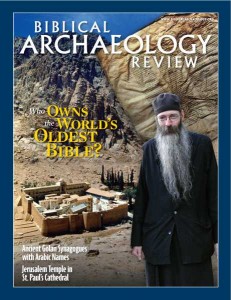Biblical Archaeology Review, November/December 2007
Features
Who Owns the Codex Sinaiticus?
How the monks at Mt. Sinai got conned
The Codex Sinaiticus contains the oldest complete copy of the New Testament—from the mid-fourth century. Originally, it contained the Old Testament too, but most of that is now missing. The Codex Sinaiticus is one of the big three—not Ford, GM and Chrysler, but Sinaiticus,...Read more ›
Why Is Sinaiticus Significant?
Codex Sinaiticus, written around the middle of the fourth century A.D., is arguably the earliest extant Christian Bible. It contains the earliest complete copy of the New Testament. Only one other nearly complete manuscript of the Christian Bible—the Codex Vaticanus—is of a similarly early date. The only...Read more ›
An American Monk in Sinai
HERSHEL SHANKS: Tell me a little about your background. FR. JUSTIN: My parents were Baptist missionaries. I was born in Texas, but when I was two, we moved to Chile. I lived there until I was nine. That’s why my accent is not a Texas accent. I...Read more ›
A Grand Cooperative Project
An investigation into the modern history of the Codex Sinaiticus is just one element in a much larger Codex Sinaiticus Project, the budget of which is nearly two million dollars. Of course the codex will be conserved with the latest conservation methods to preserve it for future...Read more ›
Golan Gem
The ancient synagogue of Deir Aziz
Of the approximately one hundred ancient synagogues from, say, 150 B.C.E. to 850 C.E. found in the ancient Land of Israel, an astounding 25 percent are located in the central Golan. How do we explain this? As it happens, one of the earliest synagogues is also in...Read more ›
Rising Again
Hi-tech Tools Reconstruct Umm el-Kanatir
In the rugged hills of the south-central Golan, a monumental ancient synagogue is rising again—literally. Its original name is lost. The Arabic name it bears today, Umm el-Kanatir (“the mother of the arches”), derives from the three beautiful stone arches built over nearby pools that capture the...Read more ›
Rebuilding—Step by Step
Preparation for the Umm el-Kanatir reconstruction project involved several steps. First, small electronic chips were embedded in the toppled blocks to give each individual stone a unique identification number. Next, using a laser attached to the crane’s winch, a three-dimensional aerial scan was taken, which recorded the...Read more ›
Is a Piece of Herod’s Temple in St. Paul’s Cathedral?
If you’d like to see what may be a piece of the Second Temple (Herod’s Temple), pay a visit to St. Paul’s Cathedral in London. I’ll tell you later where in the church it can be found. To explain how it got there, we must explore the...Read more ›
Another View: The Disappearance of Two Royal Burials
In the July/August issue of BAR, Norma Franklin describes in detail how she managed to identify two royal Israelite tombs cut into the rock beneath the monumental palace built by King Omri in Samaria in the ninth century B.C.E.a The palace and the alleged tombs were excavated...Read more ›
Past Perfect: A Visit to the Wailing Wall
Frenchwoman Colette Modiano has traveled through the Holy Land several times since her first visit in 1967. Her book, Turkish Coffee and the Fertile Crescent (London: Michael Joseph, Ltd, 1974;), describes the places she visited, the people she encountered, people’s impressions of her, and her impression of...Read more ›

